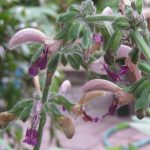Salvia bowleyana: is a very attractive unusual herbaceous perennial from China, growing to 30-40 cm H with purple and yellow flowers.

Salvia bowleyana is a winter dormant herbaceous perennial.
Flowers: are two toned, falcate shaped, having a very wide gape between the hood and the lower lobes to attract pollinating insects. The hood is large and cream with prominent violet hairs over the hood, while the bottom lobes are smaller, violet purple at the base and white throat – very attractive. Flowering in Spring into early summer above the foliage, this makes a wonderful display.
Calyces: are green, hairy and ribbed showing each lobe. The pedicels are crimson/ purple coloured. Flowers are held in whorls of 8-10 flowers around a green hairy stem. Calyces face downwards with the flowers positioned in an upward manner.
Leaves: are midgreen, long, pinnate shaped with long green petioles. All flower stems are well clothed with these pinnate leaves. Usually only one or two stems are produced, but a mature established plant will produce multiple stems.
Salvia bowleyana is a plant for a semi shaded protected position, that will require watering during the summer months. A good plant for a pot, but an established clump should do well in the garden in a protected position under deciduous trees.
A beautiful display when in flower as they are quite unusual. Plant with other woodland plants that like to grow in similar conditions.
Bees and other pollinating insects enjoy these flowers.
This Salvia flowers for a long time during summer, if kept moist. When flowering has finished, cut down the stems, clean up the basal area and mulch well. As S. bowleyana is winter dormant, the mulch will to protect the crown during the cold winter months , especially in frosty areas.
When the first shoots appear in late winter/ spring, feed and mulch to keep the root area cool during summer.
Propagation: is usually grown from seed, but cuttings can be taken in early spring and summer before the flowers appear.
Occasionally available
Back to Varieties


